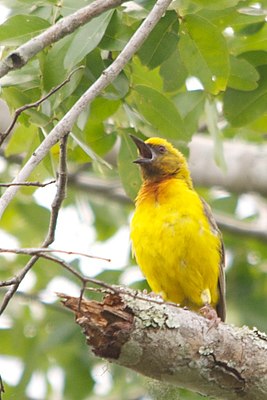Olive-head weaver
| Olive-head weaver | ||||||||||||
|---|---|---|---|---|---|---|---|---|---|---|---|---|

Olive-headed weaver ( Ploceus olivaceiceps ) |
||||||||||||
| Systematics | ||||||||||||
|
||||||||||||
| Scientific name | ||||||||||||
| Ploceus olivaceiceps | ||||||||||||
| ( Reichenow , 1899) |
The olive-headed weaver ( Ploceus olivaceiceps , Syn. Symplectes olivaceiceps ) belongs to the species of bunting ( Ploceus ) within the family of weaver birds (Ploceidae ).
The Latin additional species comes from the Latin olivaceus 'olive-colored' and the Latin caput, -ceps 'head' .
The species was previously regarded as kon-specific with the Nicoll-Weber (Ploceus nicolli).
The bird is found in Malawi , Mozambique , Zambia and Tanzania .
The circulation area covers Miombo passed habitats with plenty of Usnea , 1000-1700 m.
features
The species is 14 cm tall and weighs between 17 and 24 g. The male has a golden-yellow forehead, is mainly olive-green on the top and throat with a yellowish parting and a maroon spot in the middle of the chest. The iris is pale yellow. The female is distinguished by a green vertex, and the breast spot is paler. Fledglings are pinnate like pale females, but have more yellow on their throats.
The species is monotypical .
voice
The singing of the male is described as a short stanza with falling closing notes "tzee-twa-twa-twa", without the hissing elements typical of weavers, more reminiscent of wheatear or larks .
Way of life
The food mainly consists of insects , including butterflies , moths and beetles , as well as small wasps that claw into the bark of tree trunks and look for along the branches and twigs like tits. The species occurs singly or as a pair in mixed hunting communities.
The breeding season is in October in Zambia, between September and October in Malawi and August to October in Mozambique. The species is monogamous , at least for a year.
The nest is built by both sexes from Usnea on the underside of a thick branch up to 18 m above the surface of the earth. The clutch consists of simple turquoise or white colored eggs. Both parent birds take over the breeding business and rearing.
Hazardous situation
The stock is considered to be near threatened by habitat loss .
literature
- AR Reichenow: New species of birds. In: Ornithological monthly reports , Vol. 7, 1899, p. 7 Biodiversity Library
Web links
- Videos, photos and sound recordings of Ploceus olivaceiceps in the Internet Bird Collection
- Weaver Watch
Individual evidence
- ↑ Olivkopfweber , in Avibase - The World Bird Database
- ^ JA Jobling: A Dictionary of Scientific Bird Names. Oxford University Press. 1991. ISBN 0-19-854634-3 .
- ↑ a b c d Handbook of the Birds of the World
- ^ A b c T. Stevenson, J. Fanshawe: Birds of East Africa. Kenya, Tanzania, Uganda, Rwanda, and Burundi. Princeton University Press, 2002, ISBN 978-0-691-12665-4 .
- ↑ Old World sparrows, snowfinches, weavers
- ↑ Redlist